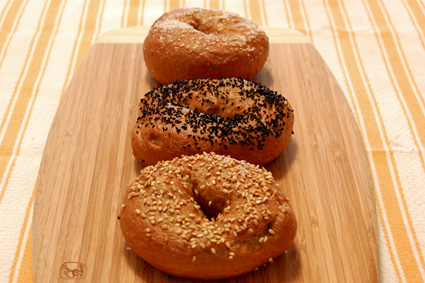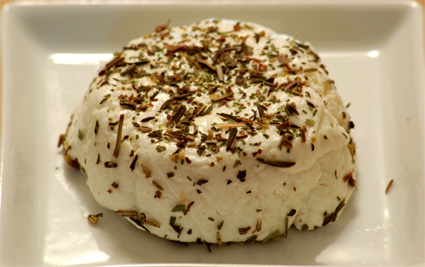Living in a small town has its pleasures: calm, quiet evenings; an absolute dearth of traffic; a small enough population base that you regularly recognize folks around town in almost no time at all. Trying to find, say, good Thai food is where you begin to realize that this may be an occasional problem. Unless you're the sort of person who thinks eating pizza with pepperoni is adventurous, the dining options in small-town America are bound to become a source of frustration at some point.
Thai food - as well as Indian, Chinese, Mexican, Caribbean and Japanese cuisines, among others - is on the list of things I need to learn to cook. Of course it would be. Finding good ingredients becomes a challenge, but it can be done. Learning new techniques and honing those skills creates a goal worth aiming for. We knew this would be the case before we moved.
Then there are those things that we'd more or less taken for granted, by which I mean bagels. There are others, and we'll certainly find those in due time, but knowing that it's a twenty-mile drive to the nearest mediocre bagels is disheartening. So I might as well add bagels to the learn-to-make list.

And it turns out that they're fairly easy, especially with a standing mixer handy. I made the first batch with molasses - lending the bagels a rich, brown color and good molasses flavor - and topped some with sesame seeds, some with chive seeds, some with salt and a few not at all. The recipe is slightly modified from the one in Mark Bittman's How To Cook Everything to use the standing mixer, rather than the food processor.
BagelsThey're crispy-skinned bagels, densely chewy and leagues better than the typical pillowy-soft bagels out of the grocery store. I'd suppose that you could vary them in nearly as many ways as you would bread, though anything that limits the effectiveness of the gluten network deserves a careful approach. An overnight rise; milk instead of water; onions or raisins or cheese kneaded into the dough; all of these would, I suspect, make great bagels.
Makes eight to twelve
IngredientsDirections
- 3½ cups bread flour
- 2 teaspoons kosher salt
- 1 teaspoon instant yeast (Note: use less yeast to effect a longer rise, which will give a better flavor)
- 2 tablespoons sweetener: molasses, honey, maple syrup, sugar, etc.
- 1¼ cups water
- Sesame seeds, poppy seeds, etc. for toppings (optional)
- Using the stand mixer's paddle attachment, mix together the flour, salt and yeast until well combined. Add the sweetener and mix for thirty seconds.
- With the mixer running, pour in the water. Mix until everything comes together into a mass of dough.
- Switch to the dough hook and knead for five to ten minutes, until the dough has become smooth and very elastic. Knead briefly on a lightly floured board, and form into a ball. Return the dough to the bowl, cover in plastic, and allow to rise at room temperature for about two hours, or until doubled in size.
- Deflate the dough ball on a lightly floured board, and allow to rest, covered, for ten minutes. Cut into eight to twelve equal pieces, and knead and roll each into a smooth ball. Pinch a hole through the center of each and stretch out, gently, into a bagel shape. Allow these to rest, covered, for thirty minutes.
- Preheat the oven to 400°F and bring a large pot of water to a boil. Being careful not to crowd them, drop the bagels into the boiling water. Work in batches as necessary. Boil for one minute on each side, then remove with a slotted spoon and allow to drain on a rack.
- Place the drained bagels on a (greased if necessary) baking sheet. If adding toppings, brush or spray the tops lightly with water and sprinkle toppings on as thickly as desired. Spray the oven with water to create steam and place the bagels inside. Bake for five minutes, spray with water again, and continue baking for another twenty to twenty-five minutes.
- Cool on a rack. For a shinier crust, spray the bagels lightly with water as soon as you remove them from the oven.
And, for those who insist on spreading cream cheese all over a perfectly good toasted bagel - I prefer good butter - I'd recommend considering a good, fresh, homemade goat cheese instead. It's remarkably easy to make, assuming you have access to good milk, and hardly takes any active effort. I stumbled across a recipe for fresh neufchâtel that takes just a tad more work than the fresh ricotta recipe I've been making from time to time. It's more cheese-flavored than milk-flavored - more acidic tang, a little less sweet - and takes more planning, but it's well worth the effort.

I followed Fankhauser's recipe as closely as possible, so it's not worth repeating the recipe here. After salting the cheese, I used a muffin pan, lined with plastic wrap, as a mold. After allowing the cheeses a little time to firm up in the refrigerator, I sprinkled them with some herbes de Provence1 from Penzey's Spices, but that's about it.
Spread it on toast or crackers; have it with some of the season's ripe heirloom tomatoes.
* * * * *
1Rosemary, cracked fennel, thyme, savory, basil, tarragon, dill weed, oregano, lavender, chervil, and marjoram.

1 comment:
yum! that looks fantastic, brian! For a good cookbook on learning how to cook Indian food, i recommend Madhur Jaffrey's "An Invitation to Indian Cooking" and "World of the East Vegetarian Cooking." The latter has good, simple Indonesian, Chinese, Japanese and Korean recipes in it as well. If you like, I can send you some of my *personal* Indian-style recipes as well. I had a friend in college who had worked in an Indian restaurant, and our friendship-group spent a lot of evenings cooking and eating large Indian meals!
Post a Comment